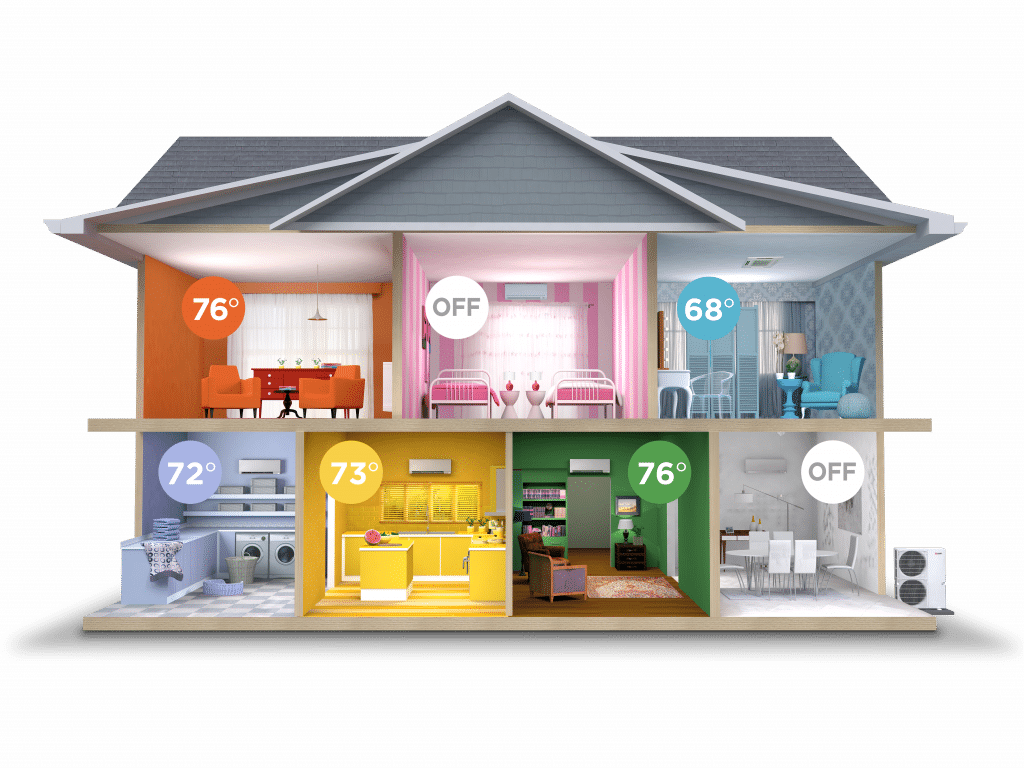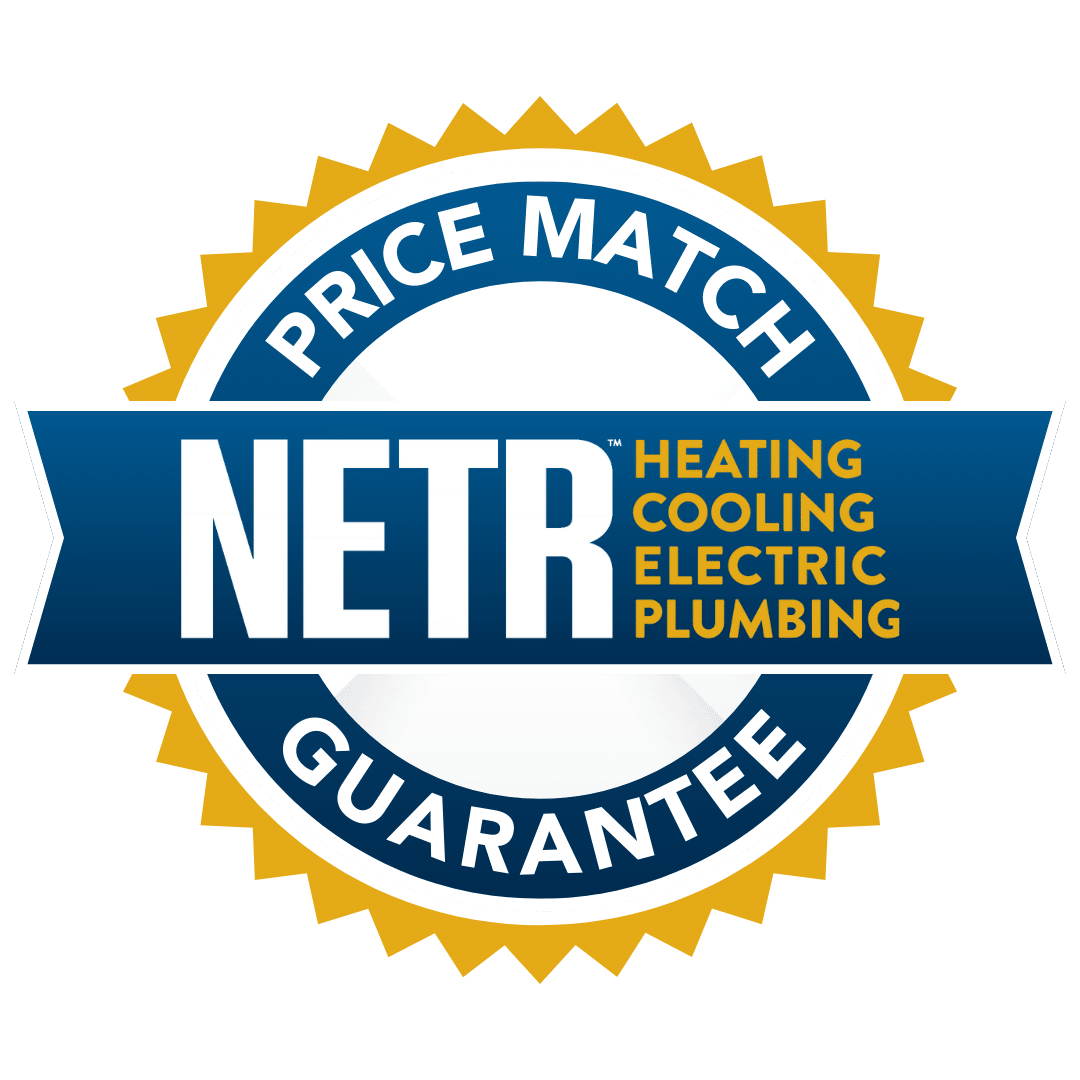At N.E.T.R., Inc. we get a lot of questions about our ductless heating and cooling systems. To help you out, we’ve gathered some of our most frequently asked questions (FAQs) about heating and cooling, and we’re putting them here with the answers you need.

What Are Ductless Heating and Cooling Systems?
Ductless heating and cooling systems do not have ducts. Instead, they feature a series of indoor air handling units that are attached to an outdoor compressor with very small tubes. The tubes carry refrigerant, electricity, and condensed water between the units, and they are housed in conduit.
How Does Ductless Heating Work?
Ductless heating systems feature a heat pump. The heat pump warms your home by moving warm air from the outside to the inside of your home. You are probably wondering how the heat pump gets warmth from cold winter air. Essentially, the heat pump takes refrigerant and moves it through an expansion valve. At that point, the gas becomes much colder than the outside air, and as a result, any heat that is in the outside air gets absorbed by the refrigerant. Then, the warmed refrigerant, travels into your home. When it gets to your air handling units, the units blow air over the warm refrigerant and that warm air is released into your home.
How Does Ductless Cooling Work?
Ductless cooling is basically the reverse process of ductless heating. The refrigerant absorbs warm air from your home. Then, it carries that air outside and releases it. When the refrigerant returns inside to your indoor air handling units, it is cold. When air runs over the coils holding the refrigerant, the air cools down and in turn makes your home cooler.
Is Ductless Heating Efficient?
On average, families save 30% to 40% on their heating and cooling bills when they switch to ductless systems. The exact savings vary based on your current heating or cooling system, your climate, and the type of home you have. To help you get a sense of your potential savings, we have put together a number of case studies. You can look for a case study in your area that matches your type of home to see how much you might save.
Can You Use Ductless Heating in Cold Climates?
In the past, ductless heating worked best in moderate climates. If you put a heat pump into an extremely cold climate, you often needed to augment your setup with another heating method such as a wood burning stove, a traditional furnace, electric baseboards, electric space heaters, or another option. Over the years, however, this technology has improved, and now there are ductless heating systems such as the Mitsubishi H2i which can heat homes and businesses effectively when outdoor temps are as low as -13º F.
How Much Do Ductless Heating and Cooling Systems Cost?
In the Boston area, quality ductless units for a single zone range from $2800 to $4500, but typically, they start at about $3500 and go up from there. That includes installation. However, if you need multiple zones, want a larger unit, or have a property with installation difficulties, the price increases. A multi-zone ductless heating and cooling system with two indoor evaporator units costs between $7500 and $8000, with installation, while a five-zone system costs about $18,000 to $22,000. However, when looking at these costs, you should keep the long-term savings in mind. Often, people save 20% to over 30% in energy costs, compared to central forced air heating-and-cooling systems.
You may bump into quotes that are lower than that. Some sites claim that a ductless system costs less than $2000 and installation is only $159. To put it simply, that price is for the cheapest, least efficient units on the market, and no quality contractor can work for that type of fee. If you decide to choose a company that offers those types of prices, be aware that you may end up facing inefficiencies and other issues in the long run.
Does Ductless Heating Add Value to Your Home?
Anytime you make upgrades to your home, you potentially increase its value. Additionally, when you put in a ductless system, your home may become more enticing to buyers who want to save money on energy or who are concerned about their carbon footprint. However, the exact effect on your home’s value varies based on property values in your area, real estate trends, and buyers’ preferences.
How Do You install a Ductless Heating and Cooling System?
To ensure your system is installed as efficiently as possible, you should hire an installation professional. The process is relatively straightforward. First, they put in the outdoor compressor. In large commercial installs, there may be multiple outdoor compressors, but luckily, their slim profile makes it easy to put them on ledges, in alleyways, on rooftops, and in similar discreet locations. Then, the installer makes a very small hole. They run conduit through that hole to all of your indoor units, and they place tubing inside the conduit. Finally, the indoor air handling units are installed and attached to the tubing.
What Do Ductless Heating Systems Look Like?
The outdoor unit looks relatively similar to a conventional outdoor air conditioning unit. The indoor units are relatively small, and they come in a range of designs and colors so that you can match your existing decor. You can also opt for recessed indoor units if you don’t want them protruding from your wall.
Where Do You Place the Indoor Air Handling Units?
Traditionally, the indoor air handling units go on external walls near the ceiling, but in some cases, you can put indoor air handling units on interior walls. You can also opt for units that go near the floor or ceiling units. Your installer will let you know which option is best in terms of efficiency and air flow.
Can You Put Ductless Heating in Garages?
Ductless systems can be a great way to add heating or cooling to garages, attics, basements, home extensions, or any other parts of your home that are not connected to your HVAC system. Because of this, many people put ductless systems or mini splits into parts of their home even if they have duct work through the rest of their home.
Can You Use Ductless Heating and Cooling for Your Whole House?
Ductless systems aren’t just for areas such as garages. They can heat and cool your entire home as well as large commercial buildings and apartment blocks. If you decide to put a ductless system throughout your whole home or commercial space, you can set up multiple zones.
How Does Zoning Work with Ductless Systems?
Ductless systems are also called mini splits because you can split the amount of hot or cold that goes into various areas. Each indoor air handling unit features its own thermostat, and you can control each unit separately. Generally, you don’t just have to put a thermostat on the wall. Instead, you can have a remote control that lets you change settings without moving, and with some systems, you can even connect everything to an app for remote control regardless of where you are.
The zone set up means if you’re not using part of your home or office, you can turn off the heating or cooling in that area to save money. Similarly, if you need to keep one area warmer or cooler than the rest of your space, you don’t have to waste energy or electricity keeping other areas at that same temperature.
How Does Zoning Work with Commercial Ductless Systems?
With a large commercial unit, you can connect the system to software that allows you to control each zone separately while also tracking energy usage in each zone. If you allow your tenants to control their units individually, you can use the software to set parameters for each zone. For instance, you can set a minimum temperature in the winter to ensure that your tenants don’t turn the heat too low and cause pipes to freeze or burst.
Are Ductless Systems Better Than Forced Air HVAC Systems?
Ductless systems boast key advantages that forced air HVAC systems don’t have. If your home doesn’t have ductwork, one of the main advantages is that you don’t have to pay to put ductwork in. You also don’t have to worry about dust or allergens building up in the ductwork and blowing into your home. Most importantly, you don’t have to deal with losing cold or hot air through the ducts. Typically, ducts run through unused parts of your home, and hot or cold air seeps out of the ducts into these unused areas. That means you spend money creating hot or cool air that you never get to use.
Are Ductless Systems Noisy?
Ductless systems are quite quiet. The indoor air handling units make about as much noise as the air gently moving through leaves on a quiet day in the forest, and the outdoor units make about as much noise as a dishwasher when you’re in the next room.
If you have additional questions or if you want to talk about putting a ductless heating or cooling system in your home or commercial space, contact us directly. At N.E.T.R., we have been helping clients for years, and we look forward to helping your family or business with your heating and cooling needs.

